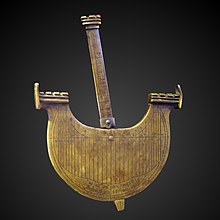Navicula de Venetiis
Appearance

A navicula de Venetiis or "little ship of Venice" was an altitude dial used to tell time and which was shaped like a little ship. The cursor (with a plumb line attached) was slid up/down the mast to the correct latitude. The user then sighted the sun through the pair of sighting holes at either end of the "ship's deck". The plumb line then marked what hour of the day it was. Some naviculas had additional information inscribed, such as the latitude of some common English towns, some zodiac signs, etc. [1][2][3][4]
References
- ^ Kristen Lippincott (1992). "The Navicula Sundial" (PDF). Bulletin of the Scientific Instrument Society. 35: 22. Retrieved 2018-07-11.
- ^ Eagleton, Catherine (2010). Monks, Manuscripts and Sundials: The Navicula in Medieval England. ISBN 978-9004176652.
- ^ "Explore Whipple Collections - A ship-shaped sundial, dated 1620". sites.hps.cam.ac.uk. Retrieved 2018-07-11.
- ^ Stebbins, Frederick A. (1961). "1961JRASC..55...49S Page 49". Journal of the Royal Astronomical Society of Canada. 55: 49. Bibcode:1961JRASC..55...49S.
This article needs additional citations for verification. (July 2018) |
